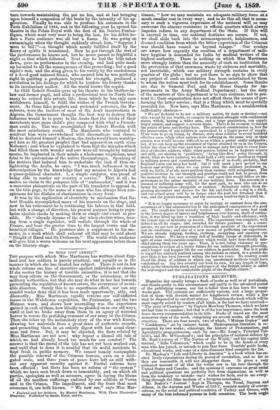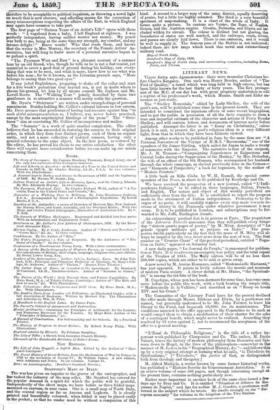PUBLICATIONS RECEIVED.
Magazine day usually brings a flush of books as well as of periodicals, and thanks partly to this circumstance and partly to the advanced period of the publishing season, our list isluller than it has been for many weeks past. The contents are sufficiently various, and a large propor- tion of them will furnish matter for lengthened review, while a few may be disposed of in our short notices. Doubtless the book which will be most eagerly seized by readers of all kinds, is the last we have received- " The story of Cawnpore" by Captain Mowbray Thomson, which we have not had time to examine ; but that is of the less importance, since the book bears itsown recommendation in its title. Books of travel are the most numerous class of the week, comprising six several works, all worthy of attention. There are four novels, two of which, "Miriam Copley" and "Confidences," are by eminent hands. Shakespearian literature is re- presented by two u ks ; ethnology, the history of Protestantism, and Apocalyptic prognostication, each by one—Mr. Long's, Principal Tnl- loch's, and Mr. M'Causland's ; and the principles of national defence by Mr. Busk's survey of "The Navies of the World," and his capital little manual, "Rifle Volunteers," which ought to be in the hands of every man who has joined, or intends to join that force. Tourists' guide books, educational works, and some of a miscellaneous kind complete the list. Dr. Maekay's "Life and Liberty in America" is a book which has ex- cited lively expectations during its period of incubation, and so far as they are reasonable it will not disappoint them. It gives a very animated account of all that the writer saw in his tour through the United States and Canada ; and the opinionait expresses on great social and political questions are perfectly free from dogmatism, as well as from the tendency to mistake one's wishes for facts, and to see every- thing through the false medium of a foregone conclusion. Mr. Senior's " Journal" kept in Therapia, the Tread? Smyrna and Athens, in the Autumn and Winter of 185-7, consists mainly of conver- sations, on the social and political condition of Turkey and Greece, with many of the best informed persons in-both countries. The book ought
therefore to be acceptable to political inquirers, as throwing a novel light On much that is now obscure, and affording means for the correction of many misconceptions respecting the affairs of the East, in which England may again have occasion to take part.
' The first page of "Sixteen Years of an Artist's Life" opens with these words : " A vagabond from. a baby, I left England at eighteen. I was perfectly independent, having neither master nor money. My pencil was both to me, being at the same time any strength, my comfort, and my intense delight !" Brave words! Who that reads them, and knows that the writer is Mrs. Murray, the secretary of the Female Artists'. As- sociation, but will long to know more of a personal narrative began in ea gallant a spirit.
"The Pyrenees West and East" is a pleasant account of a summer tour by an old friend, who, though he tells us he is not a fast tourist, yet oontrivelto cover a good deal of ground during his holiday, saw every- thing that was to be seen, and what is more, knew how to see what was before his nose ; for be it known, as the Livonian proverb says, "More belongs to seeing than two good eyes."
If any jaded Englishman' preparing to shake off the collar and start for a five week's pedestrian tour beyond sea, is yet in doubt where to choose his ground, let him by all means consult Mr. Jephson and Mr. Lovell Reeve. The "Walking Tour" jointly described by these two gentlemen in so attractive a manner will surely settle the question.
Mr. Dyce's " Strictures " are written under strongfeelings of personal resentment. Besides holding Mr. Collier's editoral labours in low esteem, Mr. Dyce accuses that gentleman of having had recourse against him "to such artful misrepresentation as' I believe, -was never before practised, except by the most unprincipled hirelings of the press." The " Stric- tures " aim at convicting Mr. Collier of incompetence and malice.
The "Sonnets" is a work of quite another complexion. The editor believes that he has succeeded in restoring the sonnets to their original order, in which they form four distinct poems, each of them an organic unity, and not a mere collection of isolated sonnets, having only a eral reference to the same object. In the first poem, as restored by
editor' he has proved his thesis to our entire satisfaction : the other
will three require more consideration before we can make up our minds concerning them.
Booxs.
27se Story of Cawnpore. By Captain Mowbray Thomson, Bengal Army, one of the only two survivors of the Cawnpore Garrison.
Life and Liberty in America.: or Sketches of a Tour in the United States and Canada in 1857-'8. By Charles Mackay, LL.D., F.S.A. In two volumes. With ten Illustrations.
A Journal kept in Turkey and Greece in the autumn of 1857 and the beginning of 1858. By Nassau W. Senior, Esq.
Sixteen Years of an Artist's Life in Morocco, Spain, and the Canary Islands. By Mrs. Elizabeth Murray. In two volumes.
The Pyrenees, West and .East. By Charles Richard Weld, author of "A Va- cation Tour in the United States and Canada," 8re.
Narrative of a Walking Tour in Brittany. By John Mounteney Jephson, F.S.A. Accompanied by Notes of a Photographic Expedition. By Lovell Reeve, F. L . S.
Rambles at the Antipodes : a series of Sketches of Moreton Bay, New Zealand, the Murray River, and South Australia, and the Overland Route. With two Maps and twelve Tinted Lithographs, illustrative of Australian Life. By S. T. Gill.
The Sonnets of William S7iakespere. Rearranged and divided into four parts. With an Introduction and Explanatory Notes.
Strictures on Mr. Collier'e New Edition of Shakespeare, 1858. By the Reve- rend Alexander Three.
Miriam Copley. By J. Cordy Jeaffreson. Author of "Novels and Novelists," "Crewe Rise," &e. &c. In three volumes.
Confidences. By the Author of" Rita."
The Wife's Temptation; a Tale of Belgravia. By the Authoress of "The Sister of Charity." In two volumes.
Confessions of a Too-Generous Young Lady. With a later continuation.
A Surrey of the Early Geography of Western Europe, as connected with the first inhabitants of Britain, their origin, language, religious rites, and edifices. By Henry Lawes Long, Esq.
Leaders of the Reformation ; Luther, Calvin, Latimer, Knox. By John Tul- loch, D.D., Principal, and Primarius Professor of Theology, St. Mary's Col- lege, St. Andrews. Author of" Theism." (Burnet Prize Treatise.) The Latter Days of Rome, as revealed in the Apocalypse. By Dominieh M'Causland, LL.D.., Barrister-at-Law. Author of "Sermons in Stones," 8re.
The Navies of the World their Present State and Future Capabilities. By Hans Busk, M.A., of Trinity College, Cambridge; Author of" The Rifle and how to use it," Ece. With Illustrations.
Rifle Volunteers : How to Organize and Drill them. By Hans Busk, M.A., 8re. With Illustrations.
The Road to Paris from London cid Folkestone, an Illustrated Guide; with a full description of Boulogne. Written by Herbert Fry. The Illustrations and Addenda by Wm. IL Prior.
A Handbook to the English Lakes. By James Payn.
The Parent's Cabinet of Amusement and Instruction.
Mental Arithmetic : containing the Principles of Arithmetic for the Learner,
and Numerous Exercises for the Teacher. By Hugo Reid, Author of the "Principles of Education," &c.
A Manual of Panctu.ation. For Self-teaching and for Schools. By a Practical Printer.
The History of Progress in Great Britain. By Robert Kemp Philp. With Illustrations.
England subsists by Miracle. By Felsham Burghley.
The Lily of Tiflis; a Sketch from Georgian Church History. Chronicleof the Hundredth Birthday of Robert Burns.
NEW EDITIONS.
The Life of John Steggall, a Suffolk Man. Edited by the Author of "Mar- garet Catchpole."
The Naval History of Great Britain, from the Declaration of War by France in 1798 to the Accession of George IV. By William James. A new edition,
with Additions and Notes. In six volumes. 'Volume II.
Rita: an Autobiography. (Bentley's Standard Novels.)
STANFORD'S MM'S OP ITALY.
The war has given an impulse to the graver of the cartographer, and has tasked the industry of the map seller. Mr. Stanford has catered for the popular demand in aripirit for which the public will be grateful. Independently of the sheet maps, we have before us three folded maps mounted on canvass,, in neat cases. One is a small map of North Italy, and the central region as far, as Ancona and Leghorn. It is clearly printed and beautifully' coloured; when folded it may be placed easily in tire pocket; so that no reader need be without a companion of this kind. A second is a larger map of the same district, equally deserving of praise, but a little too highly coloured. The third is a very beautiful specimen of map-making. It is a chart of the whole of Italy. It forms quite a picture. In cantons are Venice, the Bays of Naples, Genoa, and the Austrian empire. Croatia, Dalmatia, and Illyria are jay eluded within its circuit. The colour is distinct but not glaring, the boundaries of states are well marked, and the railways, roads, rivers, and passes are clearly laid down. There is one omission, and it would be well to supply it. The famous pass of the Stelvio is not indicated; indeed there are few maps which mark this novel, and extraordinary military road.
Map of North Italy.
Stanford's Map of Italy, 1859.
Stanford's Map of North Italy and surrounding countries, 6101W:sir Rowe Paris, and Vienna.



























 Previous page
Previous page